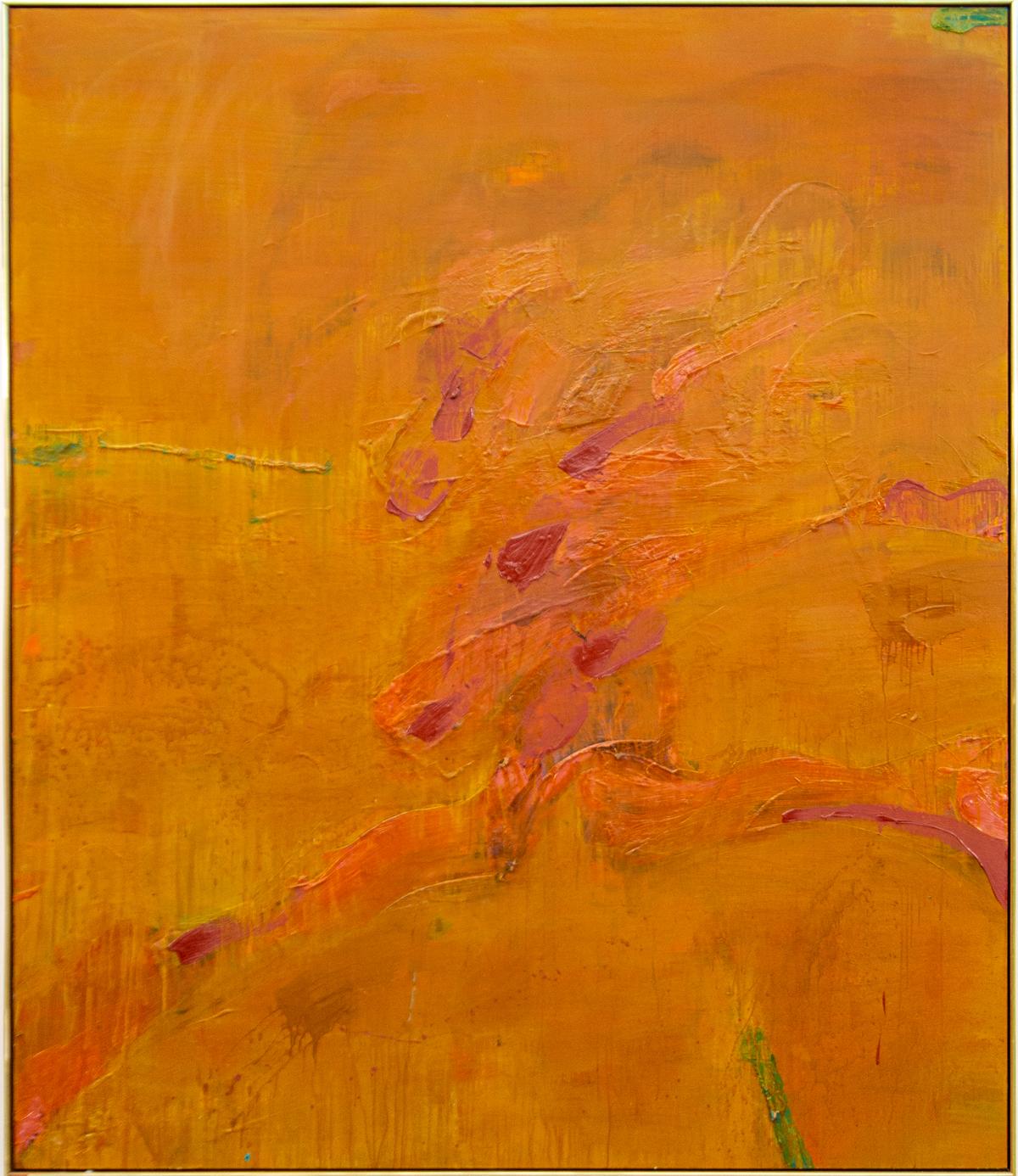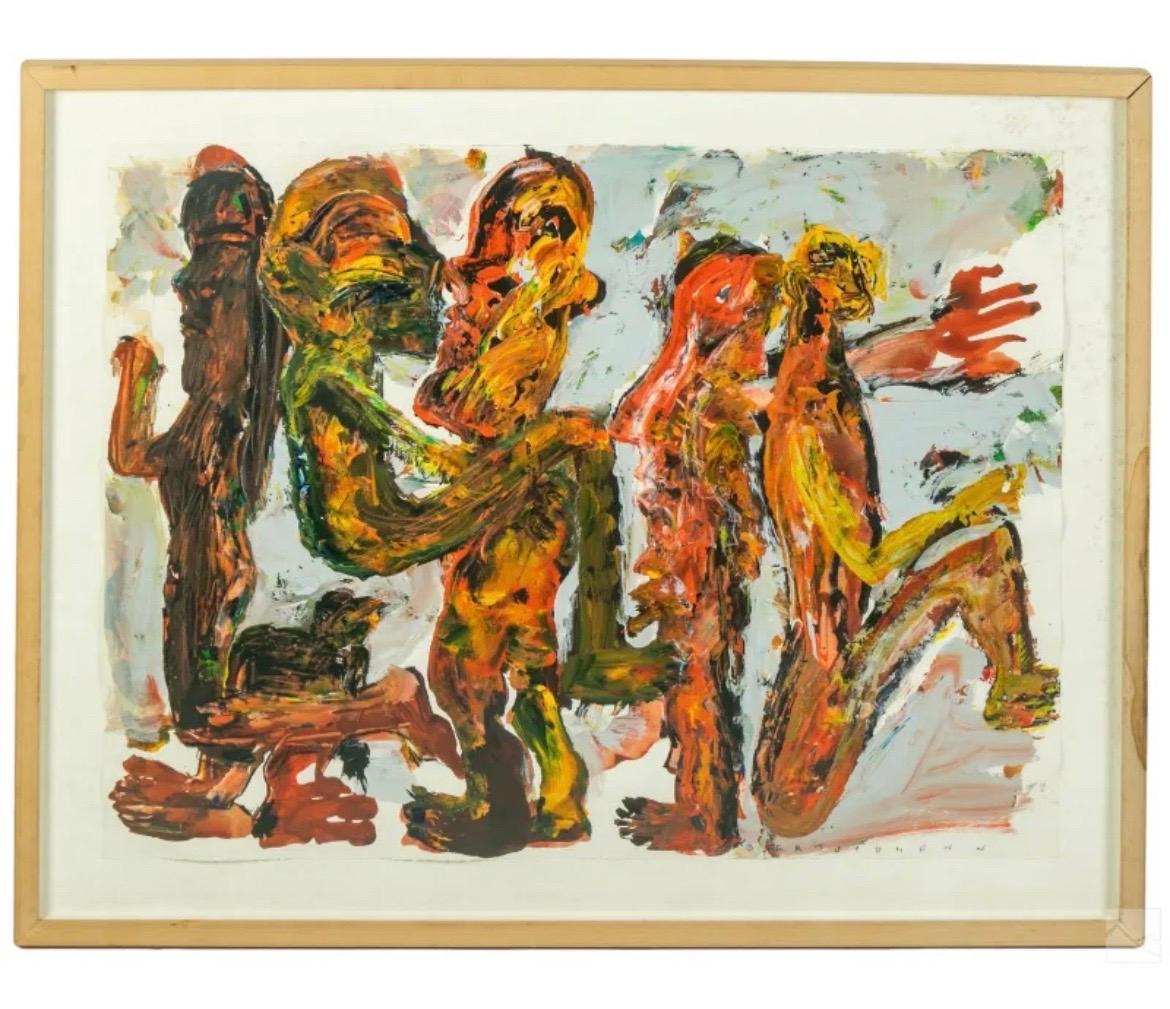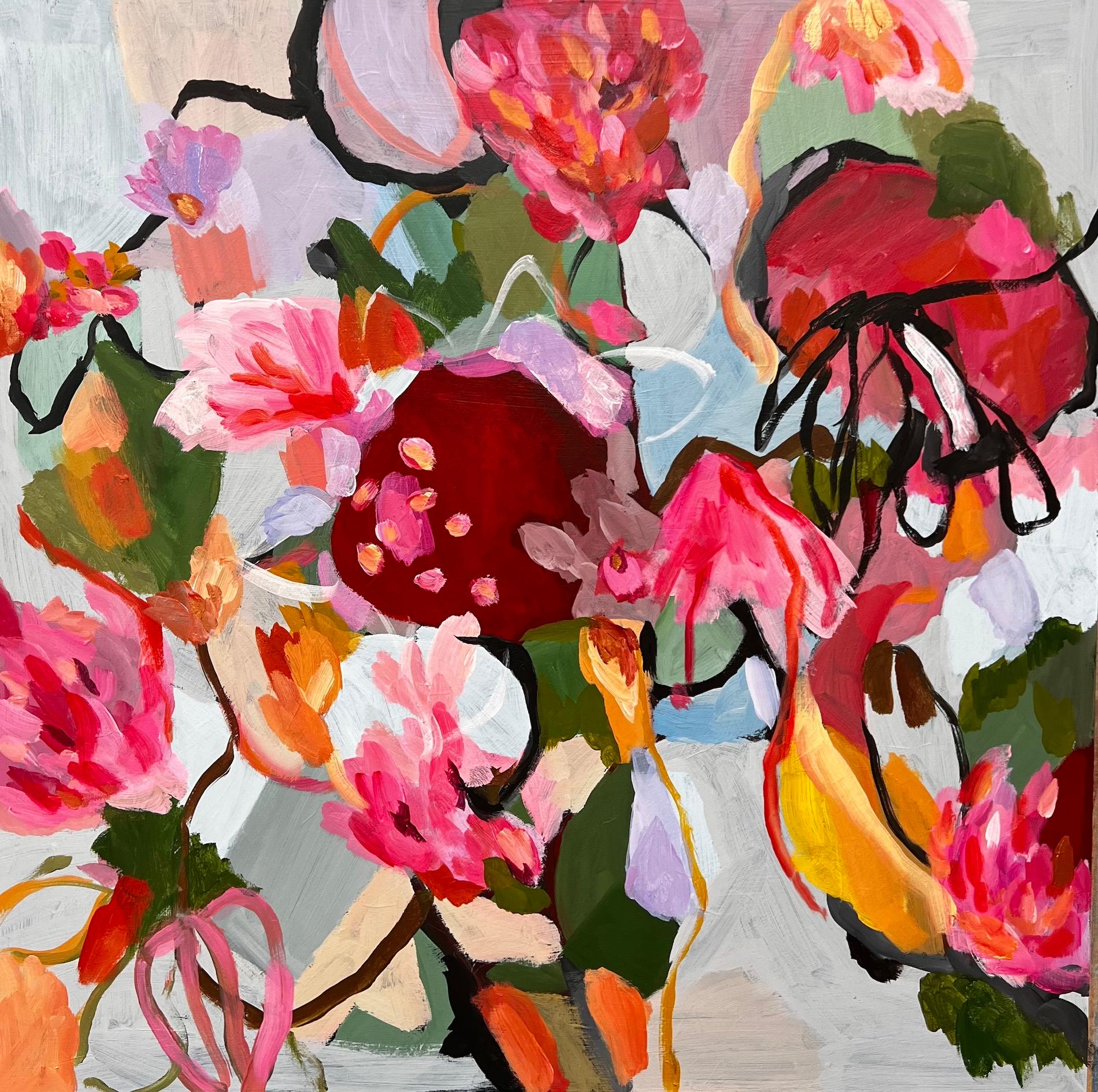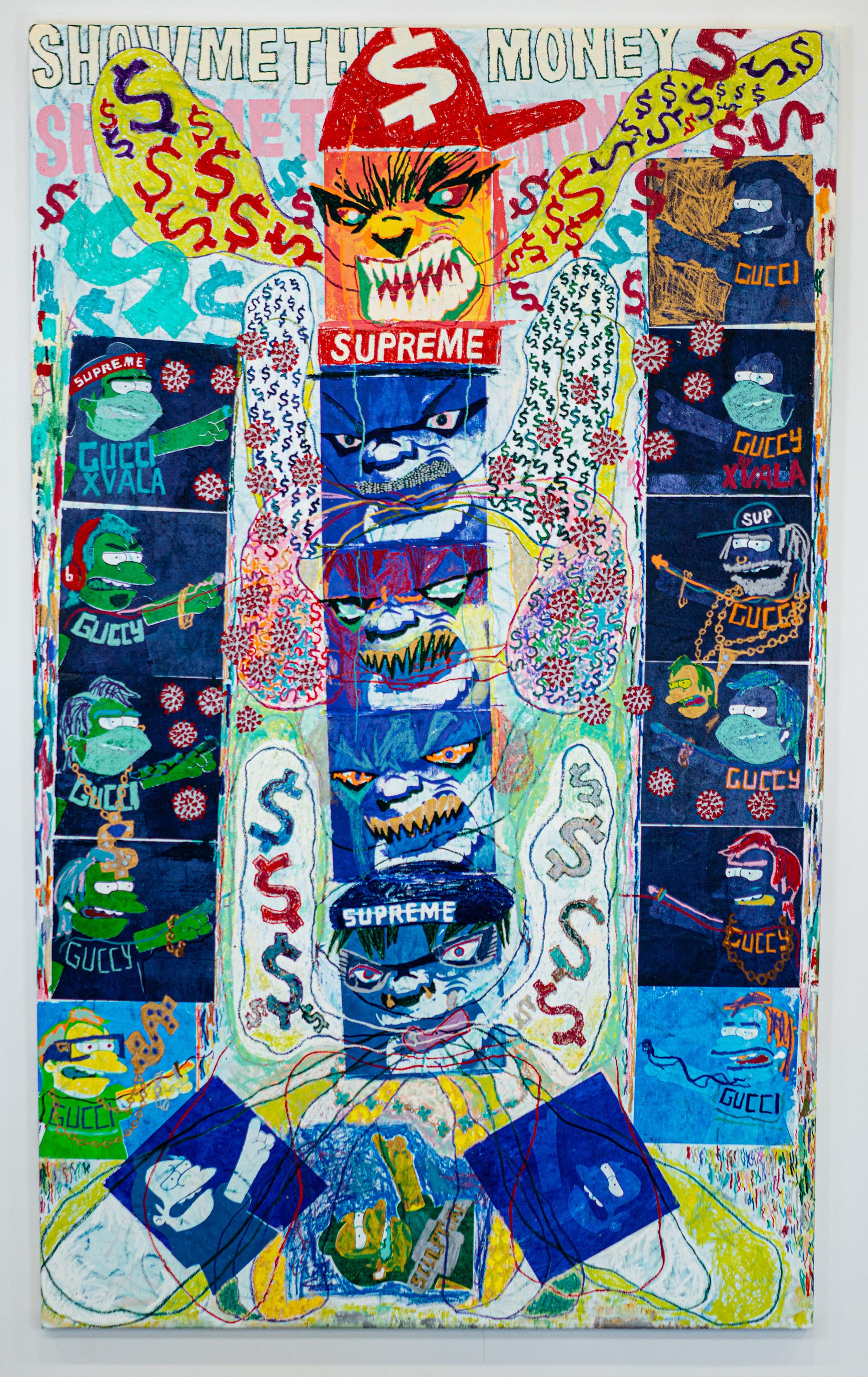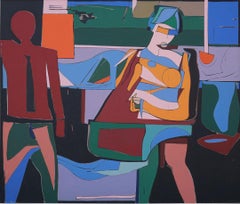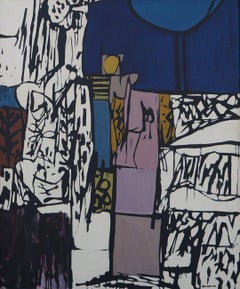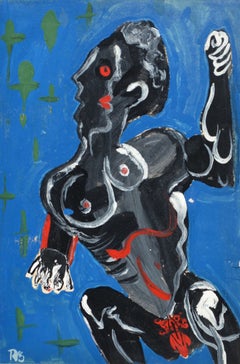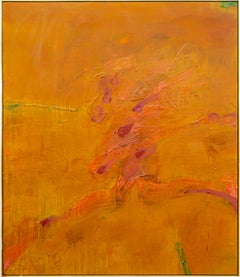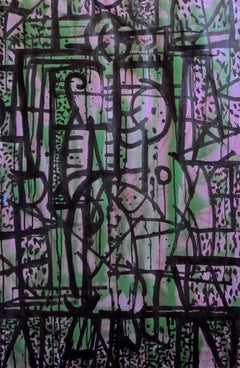
Abstract expressionist figure purple & green painting, New York artist
View Similar Items
Want more images or videos?
Request additional images or videos from the seller
1 of 11
Joseph GlascoAbstract expressionist figure purple & green painting, New York artist 1973
1973
About the Item
- Creator:Joseph Glasco (1925 - 1996, American)
- Creation Year:1973
- Dimensions:Height: 40 in (101.6 cm)Width: 26 in (66.04 cm)
- Medium:
- Movement & Style:
- Period:
- Condition:
- Gallery Location:Beachwood, OH
- Reference Number:1stDibs: LU176829740202
About the Seller
No Reviews Yet
Vetted Seller
These experienced sellers undergo a comprehensive evaluation by our team of in-house experts.
Established in 1975
1stDibs seller since 2022
9 sales on 1stDibs
More From This SellerView All
- Interior, large, colorful figural abstract red, orange, blue acrylic of coupleBy Richard AndresLocated in Beachwood, OHRichard Andres (American, 1927-2013) Interior, 1976 acrylic on canvas signed lower right, signed and titled verso 50 x 59.5 inches Richard Andres was born in Buffalo, New York in 1927. A graduate of the Cleveland Institute of Art in 1950, he was immediately drafted and served for two years in the army as a mural painter. He received his Master of Arts from Kent State in 1961. A frequent exhibitor at galleries and museums and winner of multiple May Show prizes, Andres taught art in the Cleveland Public Schools for 28 years, as well as teaching the University of Buffalo, the Cleveland Institute of Art and the Western Reserve University. Very little in Richard Andres’ childhood would have predicted his love of classical music, mid-century-modern architecture and certainly not his lifelong passion for art and in particular abstract art. Richard’s father, Raymond, had no more than a third-grade education, and his mother, Clara, was one of thirteen children – only three of whom lived into adulthood and none of whom attended high school. They lived, when Richard was a boy, in a dingy area of Buffalo, NY in a walk-up apartment situated above a tavern. Raymond and Clara supplemented the income from their factory jobs in the bar downstairs with Raymond playing ragtime on the piano and Clara serving drinks. This often left Richard and his two older brothers at home alone to fend for themselves. The two older boys, Raymond and Russell, were - unlike Richard- rather rough and tumble and entertained themselves with stickball, boxing and the like. Richard, on the other hand, from a very young age liked to draw, or better yet even, to paint with the small set of watercolors he received for Christmas one year. Paper, however, at the height of the depression, was hard to come by. Luckily, Clara used paper doilies as decoration for the apartment and Richard would contentedly paint and then cut up doilies, gluing the pieces together to create collages. At eight-years-old, he discovered the Albright-Knox Museum (then known as the Albright Art Gallery) and spent several hours a week there studying the paintings. He was particularly fond of Charles Burchfield‘s landscapes, enamored with their ‘messiness’ and thinking that they somehow captured more ‘feeling’ than works he was previously familiar with. For his tenth Christmas, he asked for and received a ‘how-to’ paint book by Elliot O’Hare. Through this self-teaching, he assembled the portfolio needed for acceptance to Buffalo Technical High School where he studied Advertising Arts. In his Junior year, he was encouraged to enter a watercolor painting, “Two Barns,” in the national 1944-45 Ingersoll Art Award Contest and was one of twelve grand prize winners – each one winning one hundred dollars. More importantly the painting was exhibited at the Carnegie Institute Galleries, which resulted in his winning a national scholarship to the Cleveland School of Art (The Cleveland Art Institute). He flourished at the art school under the tutelage of faculty members such as Carl Gaertner, as well as that of visiting artists such as William Sommer and Henry George Keller. He would say in later years that Gaertner, in particular, influenced his attitude toward life as well as art. “Gaertner,” Andres said, “believed that there was no need to be a ‘tortured artist’, that an artist should rather enjoy beauty, family, and life in general.” Free to spend his days as he chose, he wandered the Cleveland Art Museum for most of the hours he was not attending classes or painting; the remaining time was spent drinking coffee at a local hangout with art school friends – which is where he met fellow Henry Keller scholarship winner, Avis Johnson. Richard was immediately smitten with Avis, but being rather shy, it took him the entire summer of 1948 to build up his courage to ask her out. Over that summer he ‘thought about Avis’ and worked in a diner to save money. He also used the hundred-dollar prize money won in High School to visit the first Max Beckmann retrospective in the United States at the City Art Museum in St. Louis. Over a half century later he spoke of that exhibit with a reverence usually reserved for spiritual matters, “I walked in and it was like nothing I had ever seen before... the color...It just glowed.” Returning to campus in the Fall, the first thing he did was go to the coffee shop in hopes of finding Avis. He did, and she, upon seeing him, realized that she was also smitten with him. They quickly became known as ‘the couple’ on campus, and a year later, with Richard being drafted for the Korean war, they were quickly married by a Justice of the Peace, celebrating after with family at Avis’s Cleveland home. As a gift, faculty member John Paul Miller...Category
1970s Abstract Expressionist Abstract Paintings
MaterialsAcrylic
- Panama Garden, Mid-century abstract expressionist modern workBy Richard AndresLocated in Beachwood, OHRichard Andres (American, 1927-2013) Panama Garden, c. 1964 acrylic on canvas signed lower right, signed and titled verso 46 x 38 inches Richard Andres was born in Buffalo, New York in 1927. A graduate of the Cleveland Institute of Art in 1950, he was immediately drafted and served for two years in the army as a mural painter. He received his Master of Arts from Kent State in 1961. A frequent exhibitor at galleries and museums and winner of multiple May Show prizes, Andres taught art in the Cleveland Public Schools for 28 years, as well as teaching the University of Buffalo, the Cleveland Institute of Art and the Western Reserve University. Very little in Richard Andres’ childhood would have predicted his love of classical music, mid-century-modern architecture and certainly not his lifelong passion for art and in particular abstract art. Richard’s father, Raymond, had no more than a third-grade education, and his mother, Clara, was one of thirteen children – only three of whom lived into adulthood and none of whom attended high school. They lived, when Richard was a boy, in a dingy area of Buffalo, NY in a walk-up apartment situated above a tavern. Raymond and Clara supplemented the income from their factory jobs in the bar downstairs with Raymond playing ragtime on the piano and Clara serving drinks. This often left Richard and his two older brothers at home alone to fend for themselves. The two older boys, Raymond and Russell, were - unlike Richard- rather rough and tumble and entertained themselves with stickball, boxing and the like. Richard, on the other hand, from a very young age liked to draw, or better yet even, to paint with the small set of watercolors he received for Christmas one year. Paper, however, at the height of the depression, was hard to come by. Luckily, Clara used paper doilies as decoration for the apartment and Richard would contentedly paint and then cut up doilies, gluing the pieces together to create collages. At eight-years-old, he discovered the Albright-Knox Museum (then known as the Albright Art Gallery) and spent several hours a week there studying the paintings. He was particularly fond of Charles Burchfield‘s landscapes, enamored with their ‘messiness’ and thinking that they somehow captured more ‘feeling’ than works he was previously familiar with. For his tenth Christmas, he asked for and received a ‘how-to’ paint book by Elliot O’Hare. Through this self-teaching, he assembled the portfolio needed for acceptance to Buffalo Technical High School where he studied Advertising Arts. In his Junior year, he was encouraged to enter a watercolor painting, “Two Barns,” in the national 1944-45 Ingersoll Art Award Contest and was one of twelve grand prize winners – each one winning one hundred dollars. More importantly the painting was exhibited at the Carnegie Institute Galleries, which resulted in his winning a national scholarship to the Cleveland School of Art (The Cleveland Art Institute). He flourished at the art school under the tutelage of faculty members such as Carl Gaertner, as well as that of visiting artists such as William Sommer and Henry George Keller. He would say in later years that Gaertner, in particular, influenced his attitude toward life as well as art. “Gaertner,” Andres said, “believed that there was no need to be a ‘tortured artist’, that an artist should rather enjoy beauty, family, and life in general.” Free to spend his days as he chose, he wandered the Cleveland Art Museum for most of the hours he was not attending classes or painting; the remaining time was spent drinking coffee at a local hangout with art school friends – which is where he met fellow Henry Keller scholarship winner, Avis Johnson. Richard was immediately smitten with Avis, but being rather shy, it took him the entire summer of 1948 to build up his courage to ask her out. Over that summer he ‘thought about Avis’ and worked in a diner to save money. He also used the hundred-dollar prize money won in High School to visit the first Max Beckmann retrospective in the United States at the City Art Museum in St. Louis. Over a half century later he spoke of that exhibit with a reverence usually reserved for spiritual matters, “I walked in and it was like nothing I had ever seen before... the color...It just glowed.” Returning to campus in the Fall, the first thing he did was go to the coffee shop in hopes of finding Avis. He did, and she, upon seeing him, realized that she was also smitten with him. They quickly became known as ‘the couple’ on campus, and a year later, with Richard being drafted for the Korean war, they were quickly married by a Justice of the Peace, celebrating after with family at Avis’s Cleveland home. As a gift, faculty member John Paul Miller...Category
1960s Abstract Expressionist Abstract Paintings
MaterialsAcrylic
- Rainbow Mandala, Mid Century Abstract Red and Yellow Acrylic PaintingBy Clarence Holbrook CarterLocated in Beachwood, OHClarence Holbrook Carter (American, 1904-2000) Rainbow Mandala, 1983 Acrylic on scintilla Signed and dated lower right 30 x 22 inches Clarence Holbrook Carter achieved a level of na...Category
1980s Abstract Abstract Paintings
MaterialsAcrylic
- Icon Mandala, Mid-Century Figural Abstract Black, Red & White Oval Face PaintingBy Clarence Holbrook CarterLocated in Beachwood, OHClarence Holbrook Carter (American, 1904-2000) Icon Mandala, 1967 Acrylic on paper Signed and dated lower right 30 x 22 inches Clarence Holbrook Carter achieved a level of national ...Category
1960s Abstract Abstract Paintings
MaterialsAcrylic
- Green and Red Mandala, Abstract Oval Painting by Ohio Artist Clarence CarterBy Clarence Holbrook CarterLocated in Beachwood, OHClarence Holbrook Carter (American, 1904-2000) Green and Red Mandala, 1969 Acrylic on scintilla Signed and dated lower right 24.75 x 18 inches Clarence Holbrook Carter achieved a l...Category
1960s Abstract Abstract Paintings
MaterialsAcrylic
- Expanding Mandala, Black and Orange Abstract Oval Mid-Century PaintingBy Clarence Holbrook CarterLocated in Beachwood, OHClarence Holbrook Carter (American, 1904-2000) Expanding Mandala, c. 1970s Acrylic on scintilla 23 x 30 inches Clarence Holbrook Carter achieved a level of national artistic success...Category
1970s Abstract Abstract Paintings
MaterialsAcrylic
You May Also Like
- ConflictBy Ron BlumbergLocated in West Hollywood, CAAmerican artist Ron Blumberg was classically trained at La Grande Academie Chaumiere in Paris, 1932, before moving to New York where he became a National Academy artist and a member ...Category
1940s Abstract Expressionist Figurative Paintings
MaterialsAcrylic, Paper
Price Upon Request - Serie Fahrenheit ILocated in Providencia, CLSerie Fahrenheit, 2018, acrílico sobre tela, fue expuesta en el Museo Nahím Isaías, Guayaquil, Ecuador. Según la artista Fahrenheit, es una serie de obras dividida en dos trípticos...Category
21st Century and Contemporary Abstract Expressionist Figurative Paintings
MaterialsAcrylic
Unavailable$8,200 - Rajasthan - large, bold, gestural abstract, expressionist, acrylic on canvasBy Graham CoughtryLocated in Bloomfield, ONRemarkably beautiful, lush, and impressionistic in form—Rajasthan is a stunning example of Canadian artist John Graham Coughtry’s masterful use of colour. Rendered in the exotic spic...Category
1980s Abstract Expressionist Abstract Paintings
MaterialsCanvas, Acrylic
- Large Harry Bertschmann Swiss American Abstract Expressionist Outsider PaintingBy Harry BertschmannLocated in Surfside, FLHarry Bertschmann (Swiss American, born 1931). Acrylic painting on paper. Artist signature to lower right. Provenance: Joy Moos Gallery (this was exhibited at the Outsider Art Fai...Category
1990s Abstract Expressionist Abstract Paintings
MaterialsPaper, Acrylic
- GertrudeLocated in Deddington, GB‘Gertrude’ is an original abstract painting on board by contemporary artist Wendi Weller. Oil pastel mark making details are added to many layers of acryl...Category
2010s Abstract Expressionist Abstract Paintings
MaterialsAcrylic, Board
- Large Abstract Blue and Silver Portrait of John Lennon and "Imagine" Song LyricsLocated in Houston, TXLarge portrait of John Lennon, painted in the style of Jackson Pollock/Abstract Expressionism with multiple splattered colors that incorporates the lyrics of his famous song "Imagine." Signed by artist in lower right corner. Currently unframed, but framing options are available. Artist Biography: Matt...Category
2010s Abstract Expressionist Abstract Paintings
MaterialsCanvas, Acrylic


